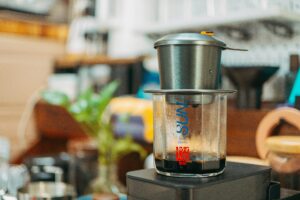Coffee culture has evolved in exciting ways over the years, and two popular summer drinks have captured the hearts of many – cold brew and iced coffee. But these beverages are not the same, and each offers a unique experience for coffee enthusiasts. Whether you’re new to the world of cold coffee or you’re an aficionado looking to deepen your knowledge, this blog post will guide you through the differences between cold brew and iced coffee, helping you choose the perfect drink to satisfy your cravings.
Understanding the Basics of Cold Brew
Cold brew is more than just cold coffee; it’s a brewing method that creates a smooth, rich, and flavorful drink. Unlike traditional hot brewing methods, cold brew involves steeping coarsely ground coffee beans in cold water for an extended period, typically 12-24 hours. This slow extraction process results in a distinct flavor profile that many coffee lovers adore.
Cold brew is known for its low acidity and mellow taste, which makes it easy on the stomach. This method also brings out the natural sweetness of the coffee beans, making it a popular choice for those who prefer a less bitter beverage. Additionally, cold brew is often served over ice, offering a refreshing and invigorating option for hot summer days.
The Process of Making Cold Brew
Making cold brew at home is simple and requires minimal equipment. Start by coarsely grinding your favorite coffee beans – the coarser, the better, as it prevents over-extraction and bitterness. Combine the grounds with cold water in a large jar or pitcher, using a ratio of 1 cup of coffee grounds to 4 cups of water.
Stir the mixture to ensure all the grounds are fully saturated, then cover the container and let it steep in the refrigerator for 12-24 hours. Once the steeping time is complete, strain the coffee through a fine-mesh sieve or cheesecloth to remove the grounds, leaving you with a smooth and concentrated cold brew.
You can enjoy cold brew as-is, over ice, or diluted with water or milk to suit your taste preferences. It can also be stored in the refrigerator for up to two weeks, making it a convenient option for busy mornings.
The Appeal of Iced Coffee
Iced coffee, on the other hand, is a more straightforward and quicker option for those who crave a chilled caffeine fix. It starts with hot brewed coffee, which is then cooled and poured over ice. This method retains the traditional flavor profile of hot coffee but offers a refreshing twist for warmer weather.
One of the main advantages of iced coffee is its versatility. You can customize it with various flavors, sweeteners, and milk options to create a drink that suits your preferences. Whether you prefer a classic black iced coffee or a creamy iced latte, there’s an iced coffee recipe for everyone.
The Process of Making Iced Coffee
To make iced coffee, start by brewing a strong pot of coffee using your preferred method – drip, pour-over, or French press. Once the coffee is brewed, allow it to cool to room temperature. For a quicker cooling process, you can place the coffee in the refrigerator or freezer for a short period.
Fill a glass with ice and pour the cooled coffee over the top. Add any desired sweeteners, milk, or flavorings, and give it a good stir. Iced coffee can be enjoyed immediately, making it a convenient option for those who need a quick caffeine boost.
Key Differences Between Cold Brew and Iced Coffee
While both cold brew and iced coffee offer a chilled coffee experience, there are several key differences between the two beverages:
Brewing Method
Cold brew involves steeping coffee grounds in cold water for an extended period, while iced coffee is made by brewing hot coffee and then cooling it down. This difference in brewing methods results in distinct flavor profiles and characteristics for each drink.
Flavor Profile
Cold brew is known for its smooth, rich, and naturally sweet flavor, with low acidity and bitterness. In contrast, iced coffee retains the traditional flavor profile of hot brewed coffee, which can be more acidic and bitter. This makes cold brew a popular choice for those who prefer a milder and less acidic beverage.
Preparation Time
Cold brew requires a longer preparation time, with steeping times ranging from 12 to 24 hours. Iced coffee, on the other hand, can be made quickly by brewing hot coffee and cooling it down. This makes iced coffee a more convenient option for those who need a chilled caffeine fix on short notice.
Customization
Both cold brew and iced coffee can be customized with various flavors, sweeteners, and milk options. However, the smooth and mellow flavor of cold brew makes it a versatile base for creative coffee concoctions, while iced coffee’s traditional flavor profile may be better suited to classic coffee recipes.
Health Benefits of Cold Brew and Iced Coffee
Both cold brew and iced coffee offer potential health benefits, depending on how they are prepared and consumed:
Lower Acidity
Cold brew is known for its lower acidity compared to hot brewed coffee, making it a gentler option for those with sensitive stomachs or acid reflux. The slow extraction process reduces the release of acidic compounds, resulting in a smoother and less acidic beverage.
Antioxidants
Both cold brew and iced coffee contain antioxidants, which can help protect your body against oxidative stress and inflammation. These antioxidants are derived from the coffee beans and can provide various health benefits when consumed in moderation.
Hydration
While coffee is not a substitute for water, consuming cold brew or iced coffee can contribute to your daily fluid intake. Staying hydrated is essential for overall health and well-being, and enjoying a chilled coffee beverage can be a refreshing way to stay hydrated during hot weather.
Choosing the Right Beans for Cold Brew and Iced Coffee
The type of coffee beans you choose can significantly impact the flavor and quality of your cold brew or iced coffee. Here are some tips for selecting the best beans for each method:
Cold Brew Beans
For cold brew, opt for medium to dark roast beans, as they tend to produce a richer and more robust flavor. Look for beans with tasting notes of chocolate, caramel, or nuts, which complement the smooth and mellow profile of cold brew. Single-origin beans from regions like Colombia, Brazil, and Ethiopia are excellent choices for cold brew.
Iced Coffee Beans
For iced coffee, choose beans that match your preferred flavor profile for hot brewed coffee. Light to medium roast beans work well, as they retain their bright and fruity flavors even when cooled. Consider beans with tasting notes of citrus, berries, or floral for a refreshing and vibrant iced coffee experience.
Enhancing Your Cold Brew and Iced Coffee Experience
There are several ways to elevate your cold brew and iced coffee experience, making each sip more enjoyable:
Experiment with Flavors
Add a splash of vanilla extract, a sprinkle of cinnamon, or a drizzle of caramel syrup to your cold brew or iced coffee for a burst of flavor. You can also infuse your cold brew with spices like cardamom or star anise during the steeping process for a unique twist.
Try Different Milk Options
Experiment with various milk options, such as almond milk, oat milk, or coconut milk, to find the perfect complement to your cold brew or iced coffee. Each type of milk adds its unique flavor and texture, allowing you to create a personalized coffee experience.
Use Coffee Ice Cubes
Prevent your cold brew or iced coffee from becoming diluted by using coffee ice cubes instead of regular ice. Simply freeze leftover coffee in an ice cube tray and use the cubes in your drink for a more intense coffee flavor.
The Environmental Impact of Cold Brew and Iced Coffee
Both cold brew and iced coffee have environmental impacts, primarily related to the production and disposal of coffee grounds:
Coffee Grounds Waste
Cold brew requires a larger amount of coffee grounds compared to iced coffee, resulting in more waste. However, you can reduce your environmental footprint by composting used coffee grounds or repurposing them for gardening and household uses.
Energy Consumption
Cold brew generally consumes less energy than iced coffee, as it doesn’t require heating water. However, the extended steeping time means that your refrigerator may use more energy to keep the brew cold. To minimize energy consumption, consider making larger batches of cold brew and storing them in an insulated container.
Sustainable Coffee Sourcing
Choose coffee beans that are ethically sourced and certified by organizations like Fair Trade, Rainforest Alliance, or UTZ. These certifications ensure that the coffee is produced under environmentally friendly and socially responsible practices, benefiting both the planet and the farmers.
Conclusion
Both cold brew and iced coffee offer unique and refreshing ways to enjoy your favorite beverage during hot weather. By understanding the differences in brewing methods, flavor profiles, and preparation times, you can choose the perfect drink to suit your preferences. Experiment with various beans, flavors, and milk options to create a personalized coffee experience that you’ll love.
If you’re ready to explore the world of cold brew and iced coffee further, we invite you to join our coffee community. Connect with fellow coffee lovers, share your favorite recipes, and discover new ways to enjoy your favorite brew. Happy sipping!
FAQs
What is the main difference between cold brew and iced coffee?
The main difference lies in the brewing method – cold brew is made by steeping coffee grounds in cold water for an extended period, while iced coffee is made by brewing hot coffee and then cooling it down.
Is cold brew stronger than iced coffee?
Cold brew is often more concentrated and can have a higher caffeine content than iced coffee, depending on the brewing ratio and steeping time. However, it can be diluted with water or milk to achieve the desired strength.
Can I make cold brew with any coffee beans?
Yes, you can make cold brew with any coffee beans, but medium to dark roast beans are recommended for a richer and more robust flavor. Experiment with different beans to find the perfect match for your taste preferences.






